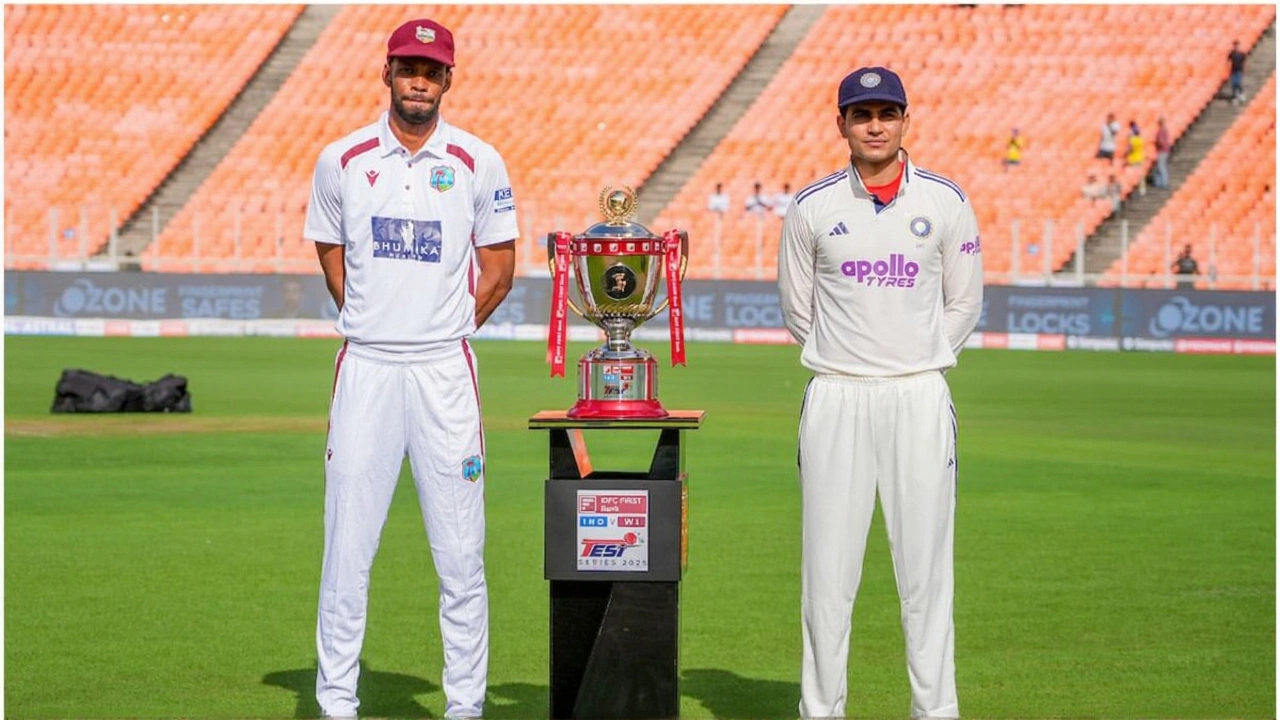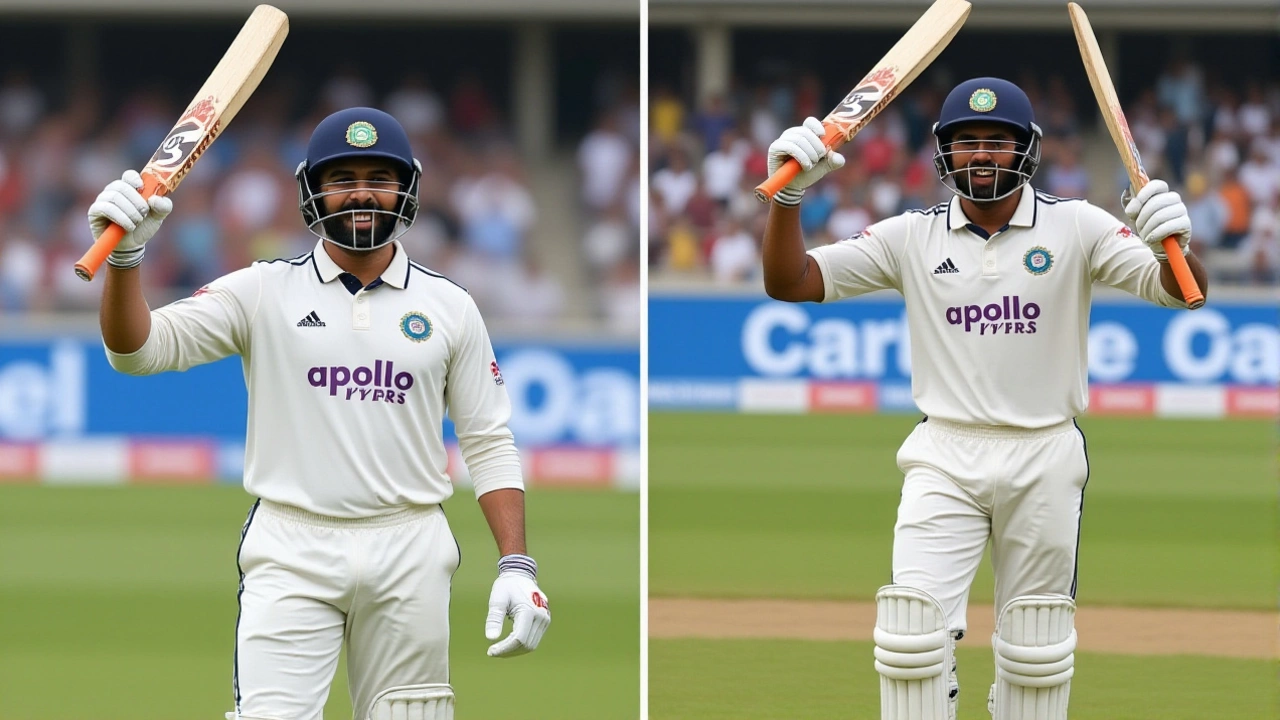
When KL Rahul, Dhruv Jurel and Ravindra Jadeja piled on centuries on Day 2 of the 1st TestNarendra Modi Stadium, Ahmedabad, the India cricket team swamped the West Indies cricket team for 327 runs, taking the scoreboard to 448/5 and carving out a 286‑run lead at stumps.
How the day unfolded
India entered the morning session trailing by 41 runs after a modest first‑day total of 411/9. The opening partnership was quickly shattered, but by the end of the first session the hosts had already erased the deficit and nudged ahead. Rahul, who had survived a nervous first‑over edge, opened with a crisp drive through mid‑wicket and reached his 11th Test hundred – his first on home soil since a 2016 knock against England. He celebrated by removing his helmet, planting a kiss on the Indian flag on his chest, and grinning at the packed stands.
Shubman Gill contributed a steady 57, anchoring the innings while the lower order settled in. The third wicket fell at 200, but the damage was already done: India led by 38 runs after 67 overs. By lunch, the scoreboard read 218/3, still a modest edge but a psychological shift.
Afternoon play saw a flurry of boundaries. Axar Patel, who had been on the field with drinks for the batters, was joined by a sweaty‑eyed umpire Richard Illingworth offering a dab of sweat‑cream to Jadeja. The spinners – Ashwin, Patel and Ravichandran – kept the run‑rate in check, but the real explosion came when Dhruv Jurel, making his Test debut, unleashed a maiden century of 125.
Jurel’s 125 was built on elegant cuts and timing, the highlight being a sweet square‑cut off a short ball from Trevor Greaves that raced to the fence. His partnership with Jadeja crossed the 200‑run mark, an unbreakable stand that left the West Indian bowlers shell‑shocked.
Key partnerships and milestones
The Jurel‑Jadeja stand added 206 runs in just under three hours. Jadeja, already on 88, pushed on to reach his sixth Test hundred, finishing unbeaten on 104. "It felt natural," Jadeja said later. "When the ball is there, you just go for it."
Rahul’s century also marked a quirky record. He became the Indian batsman with the longest gap – 2,739 days – between home Test hundreds, joining a list that includes R. Ashwin and Kapil Dev. For Jurel, the hundred was a fairy‑tale debut: the first Indian to score a maiden Test hundred in his very first match at the Narendra Modi Stadium.
Washington Sundar, stepping in after Jurel’s dismissal, saw out the day with a quick‑fire 30, ensuring India entered the overnight session with a healthy buffer.
West Indies response
West Indies managed just three wickets in 90 overs. Fast bowler Jayden Seales dismissed Yashasvi Jaiswal early but failed to sustain pressure. Spinner Khary Pierre finally broke the Jurel‑Jadeja partnership, edging a delivery to slip for a modest catch. The new ball arrived early in the third session, but Seales and Johann Layne could not shake the rhythm of the Indian batters.
Spin attack of the visitors – Jomel Warrican, Khary Pierre and the part‑time off‑spinner – produced little turn. Warrican’s shorter ball was punched straight down mid‑wicket by Jadeja. The pitch, while offering a whisper of turn early on, seemed to flatten as the day progressed, favouring the batters.
What the lead means for the series
A 286‑run advantage at the close of Day 2 puts India in a commanding position. With five days available, captain Rohit Sharma now has the luxury to declare at a time that maximises pressure on the West Indian side. The usual strategy in India‑West Indies Tests has been a single‑big‑innings declaration, but the depth of the current scorecard offers multiple routes.
From a rankings perspective, a win would see India climb to third in the ICC Test table, narrowing the gap to arch‑rival Australia. For the West Indies, the challenge is to regroup, exploit any wear on the pitch, and aim for a resilient second‑innings total.
Historical context
The Narendra Modi Stadium has hosted three Tests since its inauguration in 2020, all of which have produced high‑scoring draws or Indian victories. In 2022, India posted 619/8 against England, and in 2023 they beat Bangladesh by an innings. West Indies, on the other hand, have struggled at the venue – their highest total in the last five visits was 327.
Overall, India‑West Indies Test encounters have favoured the hosts 11‑3 in the last 20 matches. The current series is the first time the West Indies have toured India for a three‑Test set‑up since 2019, and the early dominance suggests a similar pattern may repeat.
What's next?
Day 3 will see the West Indies begin their second innings, chasing a target that could exceed 500 if India declares on 500+. Rohit Sharma is expected to declare early in the afternoon, leaving the visitors about 150 overs to chase. The bowlers – especially Jasprit Bumrah and Mohammed Shami – will have their work cut out, given the flat nature of the surface.
Meanwhile, the Indian bench is buzzing. Young fast bowler Umran Malik, who made his debut in the first Test, is eager for a spell, while veteran spinner Ravichandran Ashwin will aim to exploit any late‑session turn.

Frequently Asked Questions
How does this lead affect India's chances of winning the series?
A 286‑run lead after two days puts India in a dominant position. It allows captain Rohit Sharma to declare at a time that maximises pressure, gives the bowlers a sizeable target to defend, and lets India dictate the pace of the match. Statistically, teams with a lead above 200 at the start of Day 3 win roughly 75% of the time in Test cricket.
What milestones did Indian players achieve on Day 2?
KL Rahul recorded his 11th Test century – his first at home since 2016 – and became the Indian with the longest gap between home Test hundreds. Dhruv Jurel scored a maiden Test century (125) on debut, and Ravindra Jadeja added his sixth unbeaten hundred (104*). All three milestones came in the same innings, a rare feat in Test cricket.
Who were the key bowlers for West Indies and why did they struggle?
Fast bowler Jayden Seales and spinner Khary Pierre were the main threats, but the flat pitch offered little assistance. Seales took only one wicket (Yashasvi Jaiswal) and struggled to generate bounce. The spinners – Jomel Warrican, Pierre and the part‑timer – could not extract turn, allowing Indian batsmen to settle and accelerate.
What does this match tell us about the condition of the Narendra Modi Stadium pitch?
The pitch started with a hint of early turn but soon flattened, favouring batters. The lack of movement for both pace and spin suggests a hard, true surface that rewards technique over sheer pace. As the match progresses, the surface may crack, potentially offering more assistance to spinners on later days.
When is the next Test scheduled and what will be at stake?
The third Test starts on October 10 at the MA Chidambaram Stadium in Chennai. With the series currently 1‑0 in India's favour, the final match will decide whether the West Indies can salvage a draw or force a decider. A series win would solidify India's top‑three ranking ahead of the upcoming England‑Australia summer.
 Entertainment and Film Industry
Entertainment and Film Industry